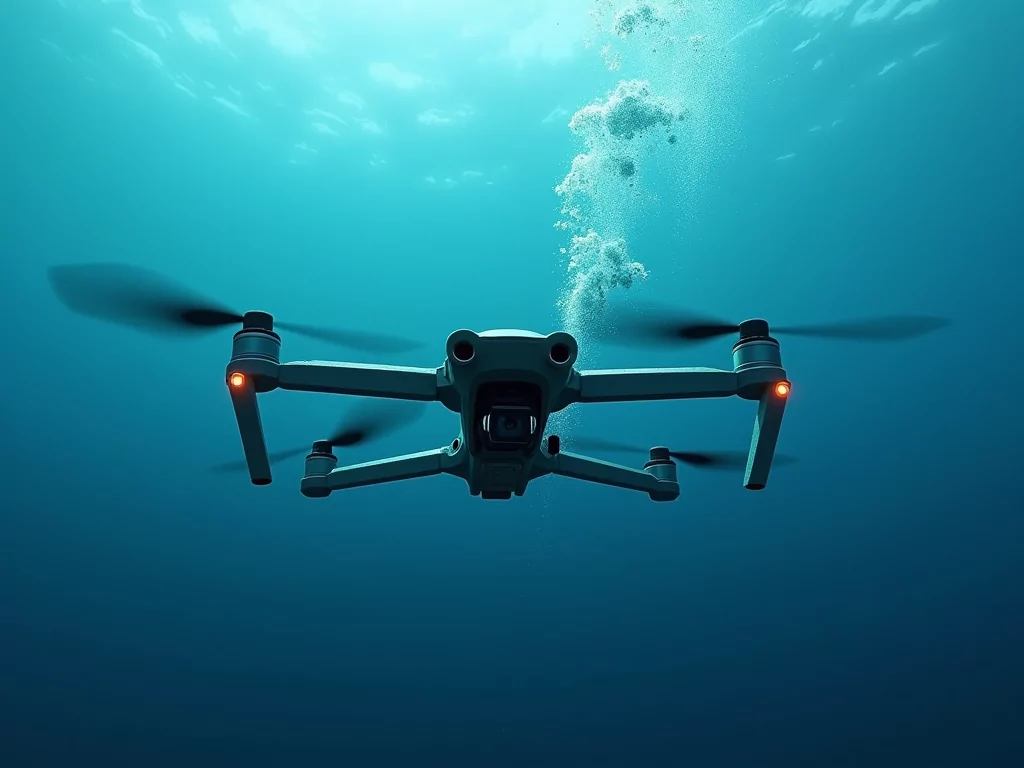Remotely operated vehicles (ROVs), underwater drones, are revolutionizing our exploration and operations in the ocean’s depths. These flexible tools allow us to reach locations and complete jobs heretofore unthinkable or quite risky for people. From business inspections and search and recovery missions to scientific study and environmental monitoring, underwater drones are proving to be great tools in many different sectors.
Benefits of Underwater Drones
Improved safety is one of underwater drones’ main benefits. Human divers can escape hazardous situations including severe depths, frigid temperatures, poor vision, and deadly fauna by sending a drone to handle underwater chores. Without endangering lives, drones may securely survey buildings including oil rigs, pipelines, and ship hulls, gather samples in polluted waterways, and hunt for drowning victims or misplaced things.
Still another big advantage is higher efficiency. Far longer than human dive lengths, underwater drones can remain submerged for hours on battery life. This lets them cover more ground, do more thorough inspections, and compile more data in one deployment. Faster and better informed decision making is made possible by drones fitted with high-resolution cameras, sonar, and other sensors rapidly and completely recording underwater circumstances.
Furthermore, using underwater drones is rather affordable compared to conventional diving operations. Using a drone usually calls for few staff members and supporting tools, so lowering the total cost. Designed especially for underwater operation, drones have robust homes and modular designs that let them be modified as needed. This flexibility increases the drone’s lifetime and operation range, therefore improving its return on investment.
Applications in Many Fields
Scientific Investigations and Discovery
For marine researchers, underwater drones have become indispensable instruments since they allow them to map the seafloor, investigate ocean ecosystems, and monitor animal activities in fresh perspectives. Without upsetting them, high-definition video and photographs taken by drones offer an up-close view of deep-sea life and ecosystems. Water sampling tools, temperature probes, and other sensors on drones enable researchers to gather important data on ocean chemistry, circulation patterns, and environmental changes.
Scientific drone missions comprise, among other things:
- Examining deep-sea habitats and hydrothermal vents
- Monitoring and marking marine life including sharks and whales
- Mapping coral reefs and observing occurrences of bleaching
- Examining subsea geology and resources
- Gathering specimens of sea life, dirt, and water
Commercial Infrastructure Examining
Underwater infrastructure, including oil and gas pipelines, offshore wind farms, hydroelectric dams, and telecommunication cables, is relied upon in many sectors. While they can be difficult and expensive to execute, regular inspections are very vital for maintaining the integrity and performance of these assets. Faster, safer, and more effective inspection options abound from underwater drones.
High-resolution cameras, sonar, and other sensors let drones investigate underwater structures for corrosion, cracks, leaks, and other problems from all angles. They can negotiate confined areas and dangerous surroundings that would be either difficult or impossible for human divers to reach. Early problem identification using drone inspections helps to minimize downtime, avert catastrophic breakdowns, and extend the lifetime of valuable assets.
Fishery and Aquaculture
The aquaculture sector is using underwater drones more and more to raise fish farming operations’ sustainability and efficiency. Fish enclosures may be inspected, stock health and behavior monitored, and jobs like net cleaning and repair handled by drones. They give farmers a reasonably priced approach to monitor their activities closely and fast spot and fix any problems.
Underwater drones can be employed in wild-catch fisheries for stock surveys, habitat mapping, and bycatch avoidance. To guide sustainable development, drones fitted with cameras and sonar can map seaflower habitats and measure fish numbers. They can also be used to track fishing equipment and spot strategies to reduce bycatch of non-target species.
Mission of Search and Recovery
From crime scene investigations to historical shipwreck documentation, underwater drones have proven to be great tools in search and recovery efforts. Drowning victims, contraband, and evidence locating and recovery are among the underwater situations law enforcement uses drones for. The possibility of a successful recovery is much enhanced by the capacity to rapidly deploy a drone and search a wide region.
Underwater drones are also used by marine archaeologists and historians to survey and record submerged cultural sites like shipwrecks. While gathering precise photographs and data for study and preservation needs, drones can safely negotiate the confined areas and fragile surroundings of a wreck. Among the well-known instances are the finds of the Bismarck, the Titanic, and ancient Roman and Greek shipwrecks.
Underwater Drone Technology: Future Prospect
As underwater drone technology develops, we should anticipate ever more creative uses and possibilities. Some areas of improvement include:
- Artificial intelligence-powered drones with autonomous navigation, obstacle avoidance, and decision-making grounded on real-time data analysis
- Coordinated fleets of drones cooperating to effectively map vast areas, monitor moving targets, or perform difficult jobs are known as swarm robotics
- Underwater docking stations enabling for longer and more autonomous flights by recharging and transmitting data from drones to enable wireless charging and communication
- Advanced sonar, chemical sensors, and 3D imaging systems offering even more comprehensive and instructive data about the undersea environment
These developments will enable underwater drones to become increasingly more important for our knowledge and use of the tremendous resources found in the ocean. From revealing the secrets of the deep sea to propelling environmentally friendly businesses, these adaptable tools are really transforming our interaction with the aquatic world.
Selecting the Correct Underwater Drone
There are more underwater drones available than ever, thus you should pick one that fits the particular requirements of your project or mission. Things to think about include:
- Depth Rating: Safely operating depth for the drone? This will rely on other design elements and the pressure housing.
- Sensors and Tools: What sensors, tools, and other gear the drone must have on hand to complete its missions?
- Maneuverability: The drone’s speed, maneuverability, and capacity to operate in currents will all be affected by the placement and power of its thrusters.
- Camera Quality: Examining the drone’s camera system’s resolution, field of view, low-light capabilities, and brightness and location of its lights helps one better understand its overall performance.
- Data Transmission: How is data sent back to the operator and how is the drone piloted? While some drones depend on wireless connection, others have a physical tether.
- User-Friendliness: Think about the learning curve and user-friendliness of the drone’s control interface as well as the simplicity of repair and maintenance.
Look for drones with robust construction, proven performance, and solid customer support to guarantee dependable operation under demanding circumstances.
Safety, efficiency, and data quality ultimately pay off when one invests in a premium, fit-for-purpose underwater drone. Unlocking the many advantages of this revolutionary technology requires careful evaluation of the alternatives and selection of a drone that fits your requirements.
In Conclusion
For industry and ocean research, underwater drones have become a transforming tool. These machines are stretching the possibilities under the waves by allowing safer, more efficient, and less expensive activities. Underwater drones are showing their worth in many different fields, from scientific study and environmental monitoring to business inspections and search and recovery.
Drone technology is developing, and we should anticipate increasingly more sophisticated capabilities and creative applications as such. Underwater drones are poised to be increasingly more important in our knowledge and sustainable use of the huge resources of the ocean thanks to artificial intelligence, swarm robotics, and improved sensors.
Investing in the correct underwater drone will provide you a strong competitive advantage regardless of your line of work—marine science, offshore engineering, aquaculture production, or another. Carefully assessing your needs and selecting a premium, fit-for-purpose system will help you to maximize the several advantages of this fascinating technology and keep ahead of your sector.
One thing is evident as we keep exploring and using the underwater environment: underwater drones are here to stay, and their influence will only get more noticeable in the years to come.
FAQs
An ROV and an AUV vary in what way?
While AUVs (Autonomous Underwater Vehicles) can run independently depending on pre-programmed instructions, ROVs (Remotely Operated Vehicles) are operated by a human pilot via a tether or wireless communication.
How deep can underwater drones reach?
Underwater drones’ depth rating changes with their design and pressure container. While specialist deep-sea drones may descend many miles, some variants are rated for a few hundred feet.
What sort of data can underwater drones gather?
Various sensors let underwater drones gather information on water temperature, salinity, pH, dissolved oxygen, turbidity, and more. Additionally, they can record sonar scans of underwater structures and habitats, video, and high-resolution pictures.
How are underwater drones powered?
Usually battery-powered, most underwater drones have batteries stored within the pressure-resistant main body. Some models might also get power and communication from a surface vessel using a cable.
Can anyone operate underwater drones?
Underwater drones’ simplicity depends on their degree of sophistication and control mechanism. Although many contemporary drones have semi-autonomous capabilities and easy-to-use interfaces to streamline operation, larger and more sophisticated systems could require specific training and support.

